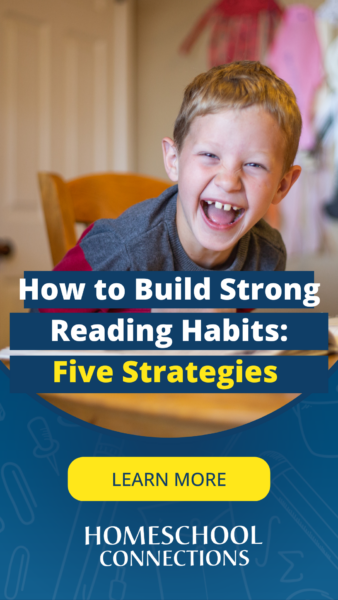5 Strategies for Building Strong Reading Habits
Tips to help your homeschooled children excel at reading.
In an age when we are bombarded with a flood of information, building sound reading skills has never been so important. A child’s relationship with the written word begins early, in the elementary years. This is when they are first exposed to the printed page and introduced to strategies to help them grow into confident readers.
Building these habits in our children might not be intuitive, however. When our child wrestles with reading, we may be at a loss as to how to help them concretely. In this article, we will review five of the easiest and most time-tested methods for assisting young children in becoming confident readers.
Read Out Loud
Having your child read out loud is the most basic reading strategy for young children. Reading out loud is effective because it triggers a dual memory process: as the child reads, he or she engages the visual memory associated with the written words on the page, while the act of vocalizing activates the child’s auditory memory, thus associating the spoken words with their meanings. Having the child follow along with his or her finger reinforces these processes of association even further.
For books to share with your beginning readers, see our article: 16 Easy Chapter Books to Encourage Emerging Readers.
Reread
One of the best ways to reinforce the meaning of a text is to reread it. This may seem fairly obvious to adults; most of us will habitually reread a passage we struggle with. This is not at all intuitive with kids, however. In fact, many young children will attach a negative moral quality to the act of rereading. They can treat the act of reading as if it’s an examination rather than a process (e.g., rereading is “not allowed” because it’s like “cheating” at reading). The best way to divest your children of this notion is to encourage them to reread passages they struggle with, as well as model rereading yourself. This does wonders for building comprehension.
Locate Key Words
Readings will often be structured around keywords. If children can be taught to identify and understand these keywords, it becomes easier to understand the passages structured around them. For example, suppose a book says the following:
Plants get their energy from the sun through a process known as photosynthesis. In photosynthesis, light from the sun is converted into chemical energy. It is the way plants make “food” out of sunlight. Photosynthesis enables the plant to change water and carbon dioxide into a sugar called glucose. Glucose is used by plants for energy and to make other substances like cellulose, which the plant uses to build cell walls.
How do we identify keywords? These are words that stand out by being unfamiliar, unusual, or critical to the passage’s meaning. Here, those words are photosynthesis, glucose, and cellulose. When confronted with a big or unknown word, many children will skim over it, which obviously makes comprehension difficult. In the passage above, a child who skips over photosynthesis will find the rest of the passage unintelligible. Help children locate the keywords in a passage and spend some time discussing their meaning. If this is planned out well, it can go hand in hand with vocabulary-building exercises.
Use Context Clues
Context is information communicated by a reading that is not spelled out explicitly. Understanding context is essential to understanding what a reading is truly saying. Children do not always grasp context intuitively. It is often necessary to teach them to think critically about the reading in order to grasp the context. This can be done using context clues, where a student uses parts of the text to infer other parts.
For example, suppose the text says, “Jacob and Michael stood in line for their tickets, bought their popcorn, and looked for their seat in the dark room.” You ask the child, “What are Jacob and Michael doing?” The child thinks about what is happening and replies, “They are going to the theater.”
This is also a good strategy for learning new vocabulary words. For example, suppose the reading says, “The jar of peanut butter was sealed; nobody had ever used it before.” What does sealed mean in this context? Using clues from the sentence, we can deduce that sealed means unopened.
Summarize the Passage
Since the purpose of reading is comprehension, it is important that a child be able to retell what he or she has read. This is the art of summary, giving a brief statement of the main points in one’s own words. Summarizing helps one recall the purpose of a passage, distilling its information down to the essentials. This is a helpful practice for young children to learn. Children can struggle to differentiate the facts from the bigger picture that the facts are pointing to. In other words, struggling to see the forest for the trees. Encouraging kids to summarize what they are reading helps them develop the ability to think in terms of what a passage is “about.”
Children who are too young to present a summary of their own or who struggle verbalizing can be given a “multiple choice” option, where they choose the most appropriate from among a series of written summaries.

Conclusion
We could discuss so much more, but this is a good place to get started! If you want to learn more about building reading skills, check out our article, 8 Tips: Homeschooling Reading Comprehension.
For an online reading program, visit True North Reading.






